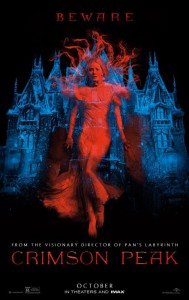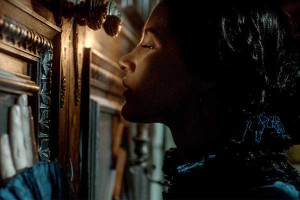Sure, the story of Crimson Peak is familiar, but the way it’s presented and the places it goes are wholly original. The film is a gothic horror story, set in an imposing 19th-century British mansion plagued by ghosts. We’ve all seen these  elements done and done again, but never with the black humor, emotional depth, and ravishing visual beauty that writer-director Guillermo del Toro brings to the material.
elements done and done again, but never with the black humor, emotional depth, and ravishing visual beauty that writer-director Guillermo del Toro brings to the material.
The film follows Edith Cushing (Mia Wasikowska), an aspiring young American author who is swept off her feet by charming British businessman Sir Thomas Sharpe (Tom Hiddleston). Sharpe has traveled to seek a business investment from Edith’s rich father (Jim Beaver), who is displeased by the budding romance between Edith and Thomas. But his disapproval is rendered moot when a mystery assailant brutally murders him, leaving Thomas and Edith free to marry and return to the Sharpe family home in England, where Thomas’ distinctly inhospitable sister Lucille (Jessica Chastain) also resides.
It’s here that things take a serious turn for the worse, in one of the most spectacularly haunted houses ever committed to the screen. The Sharpes’ rotting home sits atop a deposit of bright-red clay, which oozes bloodlike from the faucets, the walls, and the floorboards. Dead leaves and snow fall through the rotted-out ceiling into the grand foyer. And at night, as the wind whips over the chimneys, the fireplaces roar and the house seems to breathe. The house is just the centerpiece of an all-around sumptuously designed film. From costuming to sets to cinematography, del Toro and his team fire on all cylinders, creating a parade of unique, colorful and memorable visuals.
And then there are the ghosts. Edith informs us from moment one that “ghosts are real” – she saw her mother’s ghost as a child, mysteriously warning her to “beware of Crimson Peak” – but that odd experience was still no preparation for the more horrific ghouls stalking the halls of the Sharpe home. Gibbering and trailing clouds of smoky blood from the sites of their fatal wounds, these ethereal masses of exposed muscle and skeleton are not your average ghosts.
 But great design isn’t all his film has to offer. Del Toro populates his lavish nightmare landscape with a terrific cast. Wasikowska and Hiddleston both do fine work, and Chastain in particular is a bitchy delight, playing against her usual type. There’s an ugly, brutal edge to some of the material; the film contains two of this year’s most cringe-inducing scenes of violence, and its third-act revelations get pretty sordid. Del Toro knows just the right amount of wink to give us, cluing us in that he’s having fun and it’s okay to laugh at some of the more outrageous moments. But there’s also an earnest emotional undercurrent here. Del Toro turns an empathetic eye to even the film’s nastiest characters, and by the end we feel distinct senses of both catharsis and tragic loss. That’s because del Toro loves horror not just for the fantastic visuals, the scares, the gore, or the sheer fun, but also for its potential to tell human stories. He’s employed all of the genre’s capabilities to varying degrees in his previous films, but has never brought them all together in harmony as well as in Crimson Peak. It’s his best film yet, and one of the best of the year.[box_info]WHERE TO WATCH (powered by JustWatch)
But great design isn’t all his film has to offer. Del Toro populates his lavish nightmare landscape with a terrific cast. Wasikowska and Hiddleston both do fine work, and Chastain in particular is a bitchy delight, playing against her usual type. There’s an ugly, brutal edge to some of the material; the film contains two of this year’s most cringe-inducing scenes of violence, and its third-act revelations get pretty sordid. Del Toro knows just the right amount of wink to give us, cluing us in that he’s having fun and it’s okay to laugh at some of the more outrageous moments. But there’s also an earnest emotional undercurrent here. Del Toro turns an empathetic eye to even the film’s nastiest characters, and by the end we feel distinct senses of both catharsis and tragic loss. That’s because del Toro loves horror not just for the fantastic visuals, the scares, the gore, or the sheer fun, but also for its potential to tell human stories. He’s employed all of the genre’s capabilities to varying degrees in his previous films, but has never brought them all together in harmony as well as in Crimson Peak. It’s his best film yet, and one of the best of the year.[box_info]WHERE TO WATCH (powered by JustWatch)
[/box_info]

